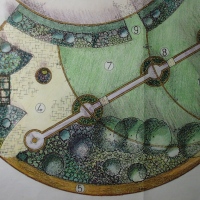 A genus of 70 or so rhizomatous perennials from central and southern Africa, Kniphofia – or ‘red hot pokers’ – can often be found in moist places; alongside river banks, in grasslands or mountainsides. They are also called tritoma, torch lily, knofflers or poker plant. The Kniphofia genus is named after Johann Kniphof, an 18th-century German physician and botanist.
A genus of 70 or so rhizomatous perennials from central and southern Africa, Kniphofia – or ‘red hot pokers’ – can often be found in moist places; alongside river banks, in grasslands or mountainsides. They are also called tritoma, torch lily, knofflers or poker plant. The Kniphofia genus is named after Johann Kniphof, an 18th-century German physician and botanist.
Kniphofia form clumps, with arching, strap-like leaves. They can be evergreen or deciduous, the leaves of the deciduous varieties tending to be narrower and shorter than the evergreens. They thrive in any soil as long as it is moisture retentive, prefer sun but will tolerate light shade and can vary from tender to fully hardy. Many tolerate coastal conditions. Coming from South Africa, they are not completely hardy, particularly in the far north. For safety grow the more hardy evergreen varieties, where you should tie up the leaves over the winter, so protecting each other from frost. They are also susceptible to ‘wet feet’ – this is particularly bad in clay soils when they are also cold.
The flowers are cylindrical or tubular and usually hang down (‘pendent’), though in some varieties are upright. Flowers are borne well above the leaves in dense spike – like racemes. The flowers come in various colours, including green and toffee, but most of the commonly seen types open red and turn to yellow, giving the characteristic, bicoloured flower spikes.
Red Hot Pokers make good cut flowers. The flowers produce copious nectar while blooming and are attractive to bees and butterflies. In the New World they may attract sap-suckers such as hummingbirds and New World orioles. They are low in allergens.
Red hot pokers seem to have suffered a bad press over the years, stemming from Victorian times when one influential garden writer (Shirley Hibberd) thought they were vulgar and that their use required “a little extra care to avoid a violation of good taste”.
Cultivars range from 50cm to 2 metres in height, and the taller ones may need staking. Late-summer flowers such as Crocosmias look good with them, as do different sorts of marigolds; e.g. ‘Touch of Red’ and ‘Art Shades’ which are ideal for a showy look. Salvia uliginosa combined with yellow or coral-coloured pokers gives a more subtle effect. They mix well in the border with other tall plants such as Alliums and Echinops. Sometimes a mixture of gaudy colours – Delphiniums, Alliums, Lilies and Knifophia – is quite attractive.
You can grow them from seed quite easily using ordinary seed compost – just push the seeds partially into the compost in April, water and they will be transplantable by summertime. Once mature, after a year of growth, the plant is dividable to increase stock. Do this in late September, into pots of 50% compost 50% grit. Dividing is easy enough, they pull apart quite easily and you can simply pot them up. Leave the divided plants in pots in a cool but frost-free greenhouse, and replant in May the next year. When transplanting your Kniphofia, dig a hole that is about 20cm deep by 10cm wide, and half fill with 50% compost, 50% grit mixture and then top up with compost and plant in this. Each spring give them a mulch with good rich compost. You can also give them a liquid feed in June when they start to show signs of flowering. I have some in my long borders at Old School Garden and they are just coming into flower.
Further information:
How to grow Kniphofias- Telegraph article
How to grow Kniphofias-Mirror article
RHS- Kniphofia ‘Bees Sunset’ and other links
Old School Gardener
If you’ve enjoyed reading this post and others on this blog, why not comment and join others by signing up for automatic updates via email (see side bar, above right ) or through an RSS feed (see top of page)?













Reblogged this on aristonorganic and commented:
A wonderful South African endemic